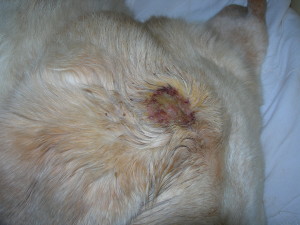
This is a horrible infection which has now reached central and northern Italy, although it was formerly more prevalent in the south of the country. It affects both humans and dogs, although so far there has not been a case of anyone in Italy catching the disease from contact with their dog.
I have personal experience of this as my 12-year-old Labrador ZsaZsa has been diagnosed with leishmaniasis and I am currently treating her in the hope of keeping it at bay. More of that later. First some facts:
What causes it?
Leishmaniasis is a parasitic infection spread by the dog being bitten by phlebotomine sandflies. These are tiny little flies, a little bit like a mosquito but blacker and smaller and with no sound. Despite the name there is no need for them to be near sand at all. They are most active between dusk and dawn from around May to September / October. They are very common all over central and southern Italy, most of Greece, the Balkans, Malta, southern France, much of Portugal and Spain and in the humid parts of North Africa. An infected dog can pass the infection back to another sandfly which in turn can bit an uninfected dog in the same household, so make sure that all your dogs are tested. Chances are if one dog has it the others may do as well.
What are the symptoms?
There are two kinds of leishmaniasis – cutaneous and visceral. Symptoms include ulcers and other lesions, hair loss particularly around the muzzle, tail and feet, there may be nosebleeds (caused by ulcers in the nose), unusually long claws which grow fast, lethargy, weight loss, vomiting yellow bile, problems with joints and articulation and anaemia. Severe infection can cause problems with the internal organs, including kidney failure. Eventual death will result.
Is there a cure?
No, it is incurable and fatal if left untreated. Saying that, there is a treatment protocol which can control and even cause remission of the symptoms and so leishmaniasis is no longer a death sentence, with some dogs doing very well indeed.
How is it diagnosed?
This is most commonly done by a blood test at the vet’s. The infection can also be detected through bone marrow or lymph gland samples, or through DNA from circulatory blood or skin.
Can it be prevented?
There is a new vaccine which has had some success, but is quite costly and needs to be administered once a year. Ask your vet about it. In addition, dogs need to be kept away from the sandflies in whatever way possible, for example keeping them inside, with mosquito nets at the windows, during the danger times (ie sunset to sunrise) as well as fitting them with special collars which prevent against sandflies, ticks and mosquitoes. Although Scaribor collars are said to be effective, my vet advised against them as they can be toxic if eaten or chewed and also need to be kept dry. My dogs wear a different kind of collar from April to the end of October.
What is the treatment?
The main and most common treatment is to administer daily injections of Glucantime for 4 weeks, the amount depending on the dogs weight and give Allipurinol tablets twice a day for at least a year, again the number of tablets (which come in 300mg form) depending on how heavy your dog is.
An alternative treatment is a combination of miltefosine tablets and allipurinol tablets is also said to be effective and may be an option when the dog’s kidneys are already damaged as Glucantime can exacerbate kidney problems. This would also be an option if you can’t give or the dog won’t tolerate injections.
Whatever happens, the dog will need to be retested regularly as relapses can occur.
